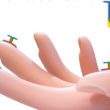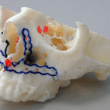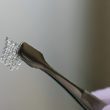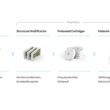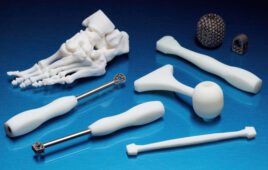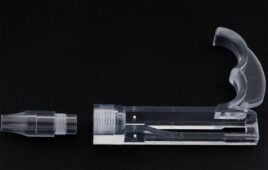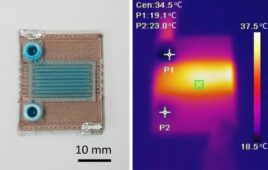You need to be fast and nimble to compete. A strong maker culture enabled by 3D design and 3D printing could be the way to do it.
Derek Mathers, Worrell
It can be a lonely world for medical and biotechnology startup entrepreneurs during the early days. Despite their deep desire to introduce and scale novel life-extending therapies, it’s rare that these pioneers have experience designing, developing, testing or commercializing medical technologies. But this global community of risk-taking leaders give our world hope for value-based healthcare systems, where devices, drugs and biologics alike are manufactured to each patients’ anatomical and genetic makeup.The bar has been raised for the modern medtech entrepreneur due to ever-litigious incumbent competitors, ever-cyclical regulatory scrutiny and the increasing costs of commercializing a new therapy.
How can startups even stand a chance in an industry naturally slated against them? One unique approach to creating a competitive advantage is developing products and winning approvals faster than any large company could ever hope to do, since they are structurally risk-averse and slow moving. I believe that small organizations can do this by hiring for and embedding a strong maker culture into the fabric of R&D – promoting agile hardware development, enabled by 3D design and 3D printing.
(See Mathers moderate a panel about 3D printing at DeviceTalks Boston on Oct. 2.)
Teach other disciplines CAD, and they will grow parts that evolve your strategy
Unlike the SaaS (software-as-a-service) industry, where a handful of developers and a decent user interface can raise millions of dollars, healthcare products typically require more capital and multi-disciplinary skills. Medical devices can only be properly introduced and commercialized when experts (outside of pure mechanical engineering) come together to build something great. You need a team with clinical, electrical, materials, physics, regulatory, sales/marketing, psychology, human factors and computer science backgrounds – to name a few.
Empowering smart people to use 3D CAD and having a capable 3D printer to materialize a design is one of the most authentic ways to communicate an idea. Perry Davidson, CEO of Syqe Medical (an Israeli respiratory health company) describes 3D printing as “hardware CAD” which his team uses “in every corner of the company.” When I toured their facility in a lively Tel Aviv neighborhood last winter, I was taken aback by the CAD literacy of everyone in the organization. From the front desk manager to pharmacokinetic specialists to the quality and testing team, they used 3D printing to improve workflows and add new functionality to critical components. When asked how he had built such a co-creative culture, Perry responded that he “made the desktop printers available to anyone who cared to use them” and “encouraged his team to learn free, readily available CAD software platforms available online.”
Don’t let the $4,000 price tag of a Solidworks seat discourage your non-ME team members from exploring the world of CAD. Encourage them to try free-to-use platforms such as Fusion360, OnShape and more that also provide educational lessons on the basics of 3D modeling so that they can come to meetings with more than just a napkin sketch, but a model that people can touch, feel, debate, destroy and improve.
Biomimicry wins, but the right anatomy is hard to find

Los Angeles–based Metamason has mastered the 3D scanning of the face to enable the printing of customized continuous positive airway pressure (CPAP) masks. [Image courtesy of Metamason]
The workflow of getting from a surface 3D scan or DICOM file (generated from CT/MRI machines) is unintuitive at best and requires both biomedical and 3D CAD expertise to be done effectively. However, some progressive organizations are utilizing new tools and workflows for getting anatomical geometries into a CAD-friendly environment.
Los Angeles–based medical device company Metamason has mastered the 3D scanning of the face to enable its scan-to-fit platform. Powered by Intel Realsense 3D scanners and their own customization engine, Metamason uses standard tablets to scan patients’ faces and prints them a customized continuous positive airway pressure (CPAP) mask out of medical-grade silicone in hours. This method of personalized manufacture is more clinically efficacious and comfortable than existing devices on the market. Metamasons’ CEO Les Karpas believes that 3D scanning technology “will be standard in consumer phones within 2 years.” The proliferation of cheap, high resolution 3D scanning technology will enable medtech startups to scan surface anatomy for design reference and makes a future of personalized medical products more tangible.
Most medtech startups can acquire CT/MR data of the correct anatomy, but getting data that is pathology-specific can be very hard to find. Moreover, converting the container file (DICOM) into a file that can be manipulated using traditional 3D tools like Solidworks is often cost-prohibitive for small companies. The dominant market player (Materialise Mimics) can cost up to $100,000 per seat for the 510(k)-cleared version.
My recommendation for startups frustrated with this space is three-fold. First, look to potential hospital partners (especially those in the Midwest) whose radiology team can get DICOM files into STL format. As companies like GE and Philips add new functionality to their portals, many hospitals can now get files into a language that printers and CAD can understand. Secondly, consider searching 3D file databases such as the University of Minnesota’s Visible Heart Lab (VHL), the NIH 3D Print Exchange, TurboSquid and Zygote. Finally, if you can’t find what you need but you have the DICOM data and not enough cash for Mimics, try a straightforward online software called Invesalius – a Brazil-based medical software with similar functionality to Mimics – free of charge.
If you don’t have a 3D printer, you’re wasting precious time
In the 3D printing industry, we classify printers into 2 broad categories: Industrial machines, which cost more than $120,000, and desktop machines that typically cost less than $10,000. The big players in the 3D printing industry have given up on desktop 3D printing. 3D Systems closed its desktop printer line in 2016, and Stratasys subsumed the best brand in desktop 3D printing, Makerbot.However, new entrants to the 3D printing market are building useful, reliable desktop machines that are used around the world to facilitate medical device innovation. These smaller desktop machines are rapidly catching up to industrial machines at a fraction of the price, with impressive resolution, printHowever, new entrants to the 3D printing market are building useful, reliable desktop machines that are used around the world to facilitate medical device innovation. These smaller desktop machines are rapidly catching up to industrial machines at a fraction of the price, with impressive resolution, print speed and new feature sets. This makes it possible for medtech and biotech startups to easily acquire them and build parts beyond prototyping. Think anatomical models, biocompatible surgical guides, office supplies, fixtures, jigs and much more. There are 2 desktop 3D printers I would recommend to startups: The Formlabs Form 2 and the Ultimaker 3.Formlabs has created an easy-to-use and powerful SLA system for desktop manufacturing in the Form 2, which produces parts in a 6-in.-squared build platform with layers less than .003 in. thick. Formlabs’s team has been on a hot streak of curating new materials for their machine. They’re building out a library that includes a fleet of engineering- and medical-grade resins, ceramics and even casting (for jewelry). For medtech startups, this reliable and useful machine comes in at a reasonable $3,500 to get started.
Formlabs has created an easy-to-use and powerful SLA system for desktop manufacturing in the Form 2, which produces parts in a 6-in.-squared build platform with layers less than .003 in. thick. Formlabs’s team has been on a hot streak of curating new materials for their machine. They’re building out a library that includes a fleet of engineering- and medical-grade resins, ceramics and even casting (for jewelry). For medtech startups, this reliable and useful machine comes in at a reasonable $3,500 to get started.
The other 3D printer – the Ultimaker 3 – is a fused filament fabrication (FFF) machine with unique capabilities. The Ultimaker 3 is one of the most progressive desktop machines on the market, able to print water-dissolvable support material and two types of model material simultaneously, and it and uses a fleet of thermoplastics such as nylon, PLA, ABS, PC and soon TPU 95A. The Ultimaker 3 also has sound reliability and an 8 in. x 8 in. x 10 in. print bed. It can print in layers as thin as .002 in. and comes in at a price point of just $3,495.
In an industry where time is of the essence, having internal, boundless access to 3D printing technology is extremely important. It is up to R&D leaders to build a maker culture within medtech and biotech startups by educating and encouraging as many people as possible to print their ideas. When team members can materialize device concepts in a shame-free, iteration-encouraging environment, they are more likely to succeed in production – and eventually in sales.
Derek Mathers is director of advanced development at Worrell (Minneapolis).
(See Mathers moderate a panel about 3D printing at DeviceTalks Boston on Oct. 2.)



